St Annes-on-the-Sea Council Tramways (1920-1922)
Lytham St Annes Borough Tramways (1922 to 1937)
History
St-Annes-on-the-Sea Urban District Council became a tramway owner and operator on the 1st November 1920, when it took over the standard gauge electric tramway of the Blackpool, St Annes and Lytham Tramways Company.
Five years earlier, Blackpool Corporation had begun wooing the council, along with neighbouring Lytham UDC, in an effort to persuade them of the mutual benefits of municipal amalgamation. Given that both UDCs would have had the right to compulsorily purchase the tramway in 1921 — based on the proportion of tracks in each of their respective municipal boundaries — it seemed highly likely in early 1920 that the company tramway would ultimately be taken over by Blackpool Corporation Tramways. At the last minute however, St-Annes performed a volte face, rejecting Blackpool's advances and instead, approaching the tramway company to see how much it would be prepared to sell for. This rather ill-thought through action, which St Annes hadn't even bothered to consult Lytham on, ended with the council agreeing to pay an eye-wateringly high price, no doubt much to the delight of the company, who would probably have had to relinquish the tramway anyway in 1921. Lytham UDC, on the other hand, who were much more circumspect, agreed to leave the way open for St Annes by waiving its right to purchase — for seven years — in exchange for a proportion of the anticipated profits. Like the company before them, St Annes-on-the-Sea UDC thus embarked on its 'tramway' journey saddled with a huge debt, one which its tramway income could not possibly hope to service.
Ironically, Lytham UDC, which had elected not to buy its share of the tramway, at least not at the price agreed by St Annes-on-the-Sea UDC, ended up becoming a tramway owner anyway, the two UDCs being merged on the 1st November 1922 to form the Borough of Lytham St Annes; as a consequence, the name of the tramway undertaking was changed from 'St-Annes-on-the-Sea Council Tramways' to 'Lytham St Annes Borough Tramways'.
At its maximum extent, the council tramway comprised 6.26 miles, running southwards from the Blackpool/St Annes boundary at Squires Gate, along the coast through St Annes-on-the-Sea to a terminus at East Beach to the east of Lytham. At the time of municipalisation, the tramway had through-running agreements in place with Blackpool Corporation, which allowed council tramcars to run through to Manchester Square (on the promenade) and Central Station (at the end of Blackpool's Central Drive tramway). From January 1923 however, a new agreement was reached which would ultimately see LStABT cars reach as far north as the Gynn on regular services, as well as running along Blackpool's newly built South Promenade (from July 1928). Other than for a short section in Squires Gate Lane, Blackpool Corporation never operated regular services over LStABT tracks, only the odd special ever venturing south of Squires Gate.
The through-running agreement was very much a double-edged sword; although it undoubtedly increased the number of passengers travelling to St Annes and to Lytham, the council tramway had to hand over all the receipts from passengers it transported within Blackpool (a significant proportion of those carried) to the corporation; in return the latter paid an agreed rate towards running costs. Moreover, in order to provide these services, the cash-strapped council had to buy additional tramcars, ten extravagantly fitted-out vehicles arriving in 1924 — which soon earned the nickname 'Blue Pullmans' — a number which from the start was insufficient to cover the demand.
The council also branched out into motorbus operation in 1923, which though ultimately successful, incurred a loss throughout the 1920s, which added yet more pressure to the tramways department. Although healthy numbers of passengers were carried, a significant proportion of income disappeared into Blackpool's coffers, the resulting profits being insufficient to cover the interest on the loans and sinking funds. As the losses mounted year on year, and with criticism of the council's decision to purchase the tramway never far away, the tramway itself was forced to manage on a shoestring. This was most noticeable with the track, much of which was 30 years old, a never-ending round of grinding, hardening and welding being undertaken in an effort to keep the purchase of new track to the absolute minimum. Further savings were made by withdrawal of services over the unremunerative section of line from Lytham to East Beach (on the 22nd July 1926), though it was to be another three years before the track was finally removed.
In April 1930, with the number of buses and bus services increasing, and by this time finally making a profit, the name of the concern was changed to Lytham St Annes Corporation Transport. In the same year, the traffic potential of the area attracted the attention of Ribble Motors; although discussions were held, the company's offer to take-over services was judged inadequate, as it would not only have required the council to close the tramway and forego municipal transport operation, but also, and most unpalatable of all, it would still have left the council with its tramway debt.
Another potential suitor appeared in 1935 — Blackpool Corporation — the mood along the Fylde coast once again favouring the creation of a larger municipality. Behind-the-scenes meetings between the towns' transport undertakings, as well as a small number of council officials, explored the various options, resulting in a proposal for Blackpool Corporation Transport to take over the running of Lytham St Annes trams and buses. The deal looked a pretty good one, not only was the decrepit track going to be relaid and an equivalent service be provided, but the price paid would virtually, if not entirely, pay off the accumulated debt. Although agreement seemed to be almost in the bag, opposition suddenly arose from Lytham councillors, who were far from impressed by the recommended replacement of the tramway services south of St Annes with motorbuses. History thus came to repeat itself, Lytham St Annes Borough Council rejecting Blackpool's offer, as well as another approach from Ribble Motors, in favour of running their own transport services.
The decision to abandon the tramway was effectively made on the 19th June 1936 when the council voted to approve a new bus service coordination scheme — with Blackpool Corporation — which would see the trams replaced by buses. New buses were ordered, with the first tramway abandonment, between St Annes and Lytham, taking place on the 13th December 1936, and the last tram of all running on the 28th April 1937. The council was however to remain a tramway owner for another 24 years, as a short section of track along Squires Gate Lane remained in place up until October 1961.
Uniforms
Following the council take-over of the 1st November 1920, motormen and conductors continued to wear the uniforms issued by the company. These comprised single-breasted jackets with five buttons, two breast pockets (with button fastened flaps), epaulettes (with button fastening) and upright collars; it seems likely that the company collar insignia was dispensed with, though how long this took is unclear. Caps were military in style with a tensioned crown and carried standard, 'off-the-shelf', script-lettering grade badges, either Motorman or Conductor, above which, the company cap badge was initially worn.
Curiously, a photograph taken in July 1921, over 8 months after the municipal take-over, includes a total of 13 motormen and conductors, all of whom are wearing company cap badges, suggesting that their use continued for at least this length of time. Although this is on the face of it a little perplexing, especially given that an example of a St Annes-on-the-Sea Council Tramways cap badge has survived (see below), council officials had been in merger talks with Lytham UDC since 1920, which suggests that they may have initially requested a sample for consideration, but then held off ordering them when they realised the name of the tramway would soon change. The fact that the example shown is the only one known, and matching buttons are completely unknown — suggesting that they probably never existed — supports, though by no means proves, this theory.
Following the merger with Lytham UDC on the 1st November 1922, the style of new uniform issues appears to have been identical to that used in company days, though presumably with nickel Lytham St Annes Borough Tramways buttons and badges. It is currently unclear what collar insignia, if any, was worn following the change in name. The old company cap badge was now replaced by a new nickel cap badge, which comprised: the new borough shield above a ribbon containing the system title: 'Lytham St Annes Borough Tramways'; grade badges continued to be worn beneath the new badge.
It is likely that new uniform issues after May 1930 would have borne Lytham St Annes Corporation Transport badges and buttons, which save for the name were virtually identical to their predecessors. This may however not have happened until May 1934, when a new style of jacket was issued, but to conductors only, motormen retaining the old style of jacket due to the exposed driving platforms. The new conductor jackets were in blue cloth and were double-breasted with lapels, so were worn with a shirt and tie; there is some evidence to suggest that the grade badges were also dispensed with, either at this time or in the final years of operation.
Tramcar staff were also issued with double-breasted greatcoats with high, fold-over collars; as in company days, these do not appear to have carried any insignia. Motormen (and probably conductors too) also wore a licence, usually hung from a greatcoat button or from an epaulette button; it is currently unclear what form the licence took, though it is entirely possible that staff simply continued to wear the same white on red enamel 'Blackpool, St Annes and Lytham Tramways' licences that they had worn in company days, i.e., prior to 1920 (see below).
Inspectors wore single-breasted jackets edged in a finer material than the main body, with hidden buttons (or more likely a hook and eye affair), a slit breast pocket (on the bearer's left-hand side) and upright collars; the latter bore the grade — Inspector — on the bearer's left-hand side, with system initials on the right-hand side, both in embroidered script lettering. Some versions of the jackets carried braided epaulettes. Caps were military in style with a hat band bearing the grade in embroidered script lettering; in St Annes-on-the-Sea Council Tramways days, a round badge of unknown pattern (with a garter-like protrusion at the bottom) was worn above this. Following the amalgamation with Lytham UDC, the round badge was replaced by the standard LStABT cap badge. In May 1934, a completely new style of uniform was issued in blue cloth: the jackets were now double-breasted with lapels, giving a smarter more modern feel, and were worn with a shirt and tie.
Inspectors were also issued with long, single-breasted overcoats with hidden buttons (or a hook and eye affair) and fold-over collars; the latter were piped and bore the grade — Inspector — on the bearer's left-hand side, with system initials on the right-hand side, both in embroidered script lettering.
My thanks to Brian Turner for much of the background information and most of the photos below.
Further reading
For a detailed history of the system, see: 'Lytham Trams — The Blackpool, St Annes & Lytham Tramway' by Brian Turner; self published (2020).
Images
Motormen and conductors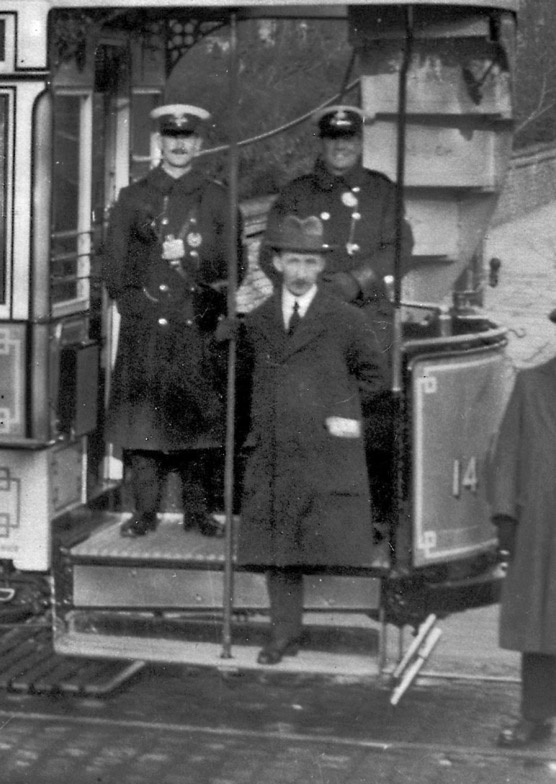
A conductor and a motorman stand on the platform of Tramcar No 14 on the 1st November 1920, which had been newly painted in 'St Annes-on-the-Sea Council Tramways' livery for the launch of the new municipal enterprise. Although impossible to discern on the photo, it is extremely likely that both men are wearing the old company cap badge. Their licences are clearly visible, almost certainly of the type used in company days (see below). Photo courtesy of the Brian Turner Collection.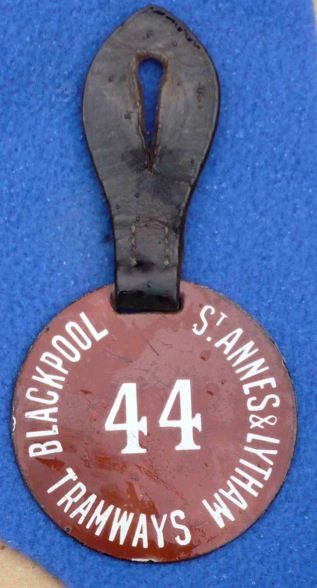
BStALT licence — white lettering on red enamel. These were probably worn by tramcar staff throughout the life of the tramway (1896-1937), though a change in form following municipalisation in 1920 cannot ruled out. Author's Collection.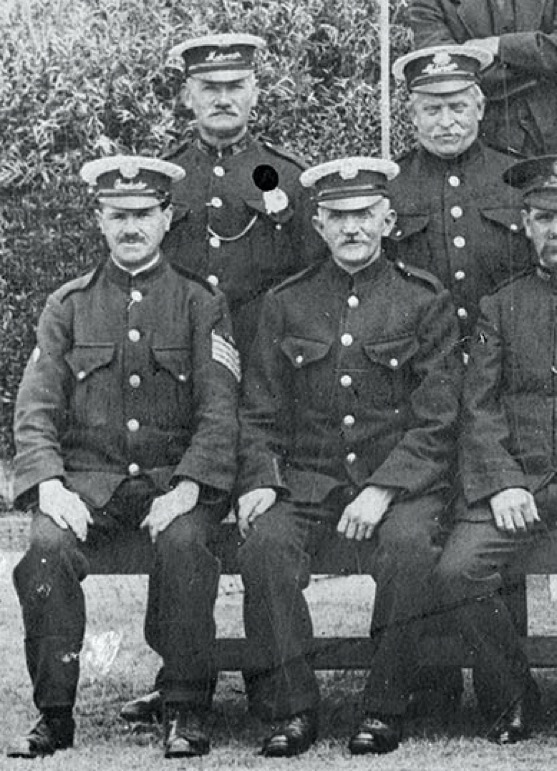
An enlarged section of a photo taken in July 1921 to mark Manager Harry Laing's fifteen years of service. The men pictured are Motorman L. Lodge (back row; left), Nightwatchman Albert R. Arnott (back row; right, who was probably an ex-motorman), Conductor Robert Wetherall (front row; left) and Motorman John J. Wilkinson (front row; right). These four men, as well as the nine other tramcar staff in the larger photo, are wearing uniforms identical to those used in company days, though all save one are devoid of insignia, the exception being Motorman Lodge who is wearing 'B & LT' system initials on his collars. Surprisingly, all the tramcar men in the photo are wearing company cap badges, rather than St Annes-on-the-Sea Council Tramways badges, despite the fact that the photo was taken over 8 months after municipalisation. Conductor Wetherall also has sergeant's stripes on his jacket arm; these possibly denoted good conduct or a degree of seniority. Photo courtesy of the Brian Turner Collection.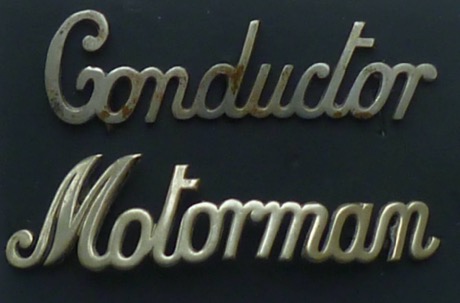
Standard 'off-the-shelf', script-lettering cap badges of the type worn by St Annes-on the-Sea Council Tramways and Lytham St Annes Borough Tramways staff — nickel. Author's Collection.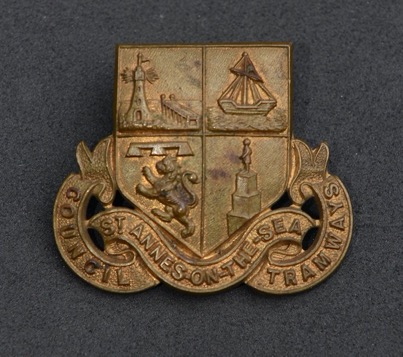
St Annes-on-the-Sea Council Tramways cap badge — gilt. Given that the 1921 'long service' photo above does not show a single example of this badge, it seems likely that it is a pattern book example that was made for consideration by the council, but never ordered. The fact that no other examples are known, nor have any 'St Annes-on-the-Sea Council Tramways' buttons ever come to light, would tend to support this. A likely scenario is that the council requested a sample badge, but then postponed ordering as by 1921, as by this time it was clear to key council officials that a merger with Lytham UDC was on the way. Photo courtesy of John Lodge.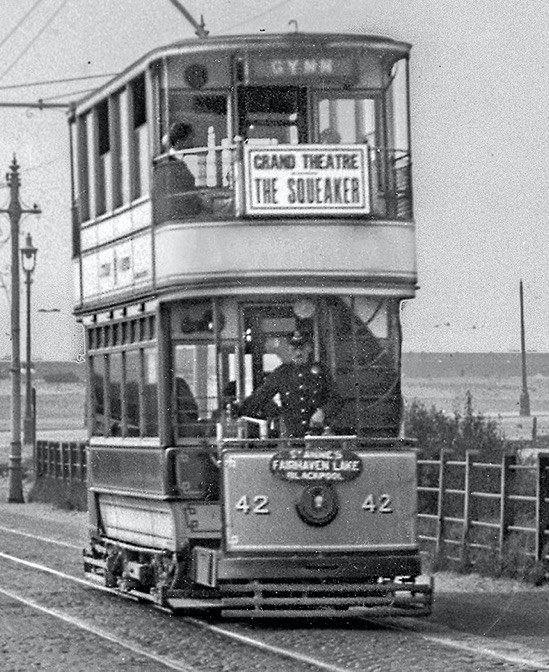
LStABT Tramcar No 41 in Squires Gate Lane heading towards Blackpool —photo undated, but certainly taken no later than August 1929. The photograph clearly shows that the uniforms at this date were still single-breasted with breast pockets. The motorman's cap bears a script-lettering grade badge, with what would certainly have been a Lytham St Annes Borough Tramways cap badge above. His licence, hung from his left-side epaulette button has nicely caught the light. Photo by G. N. Southerden, courtesy of the Brian Turner Collection.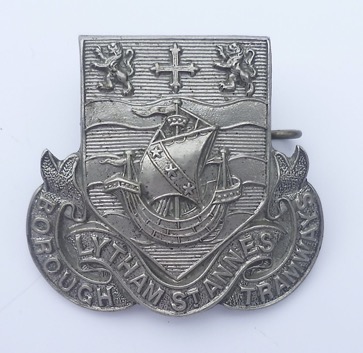
Lytham St Annes Borough Tramways cap badge — nickel. This cap badge was probably issued to tramcar staff from late 1922 through to the early 1930s, when it would probably have been replaced by the 'Transport' equivalent. Author's Collection.
The conductor and motorman of Tramcar No 45 captured in animated conversation at Gynn Square on the 22nd July 1931. The distinctively shaped badge seen on the motorman's cap may be a new Lytham St Annes Corporation Transport issue given that the department changed its name the previous year, however, as the shape is identical to the previous Lytham St Annes Borough Tramways cap badge, it is impossible to say which it is. Photo by G. N. Southerden, courtesy of the Brian Turner Collection.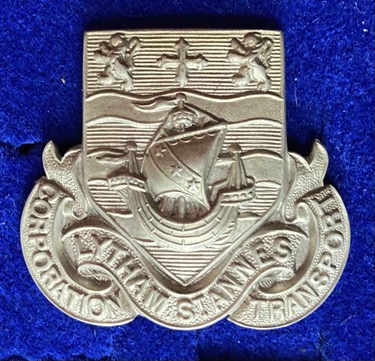
Lytham St Annes Corporation Transport cap badge — nickel. This pattern of cap badge would very probably have been issued from the early 1930s onwards, the department responsible for running the trams having changed its name in April 1930. Photo courtesy of the Author's Collection.
A LStAT motorman, in greatcoat, at the controls of a 1-20 series tramcar in 1935. Photo courtesy of the Brian Turner Collection.
Senior Staff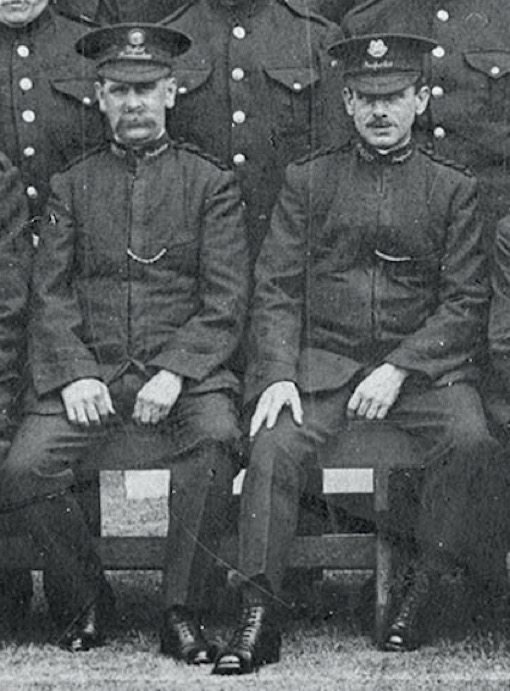
A section of the 'long service' staff photo taken in July 1921, showing Inspector William McKinley (left) and Inspector R Fletcher (right). Both men have the grade 'Inspector' on their left-hand collars, with what are probably system initials on the right-hand side. Inspector McKinley's cap bears a round badge of unknown pattern (with a small protrusion at the bottom), as well as a double-line of embroidered script lettering on his hat band, suggesting that he may in fact be the Chief Inspector. In contrast, Inspector Fletcher's cap clearly bears a Blackpool, St Annes and Lytham Tramway Company cap badge. Photo courtesy of the Brian Turner Collection.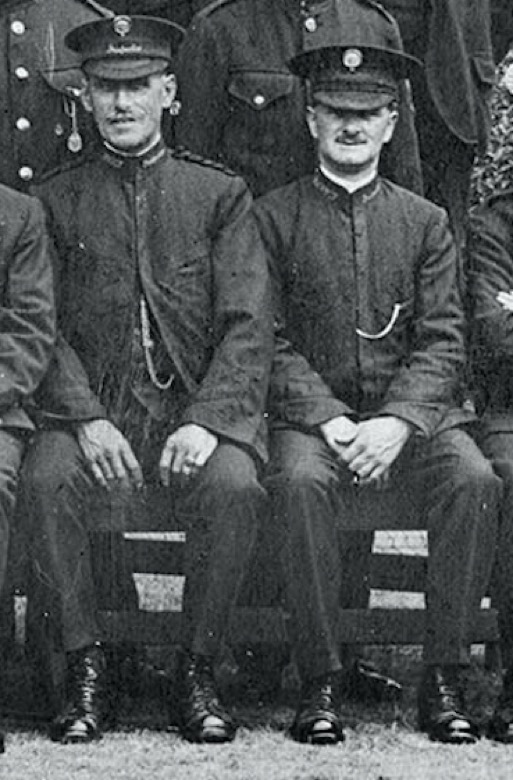
Another section of the 'long service' staff photo taken in July 1921, this time showing Inspector John Greenwood (left) and Inspector E. Taylor (right). Inspector Greenwood's jacket has braided epaulettes, whereas Inspector Taylor's does not. Both men are wearing the round cap badge (with small protrusion at the bottom) seen on the previous photograph. Photo courtesy of the Brian Turner Collection.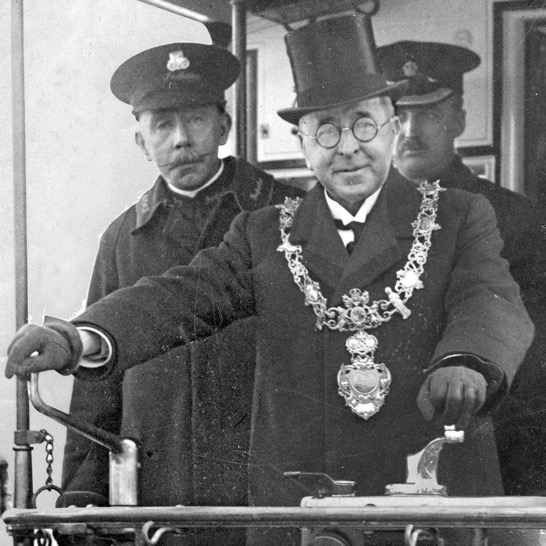
Inspector Thomas McEvoy accompanies the Mayor of Lytham St Annes as he poses for the press cameras at the controls of brand-new 'Pullman' car No 41 on the 12th May 1924. Photo courtesy of the Brian Turner Collection.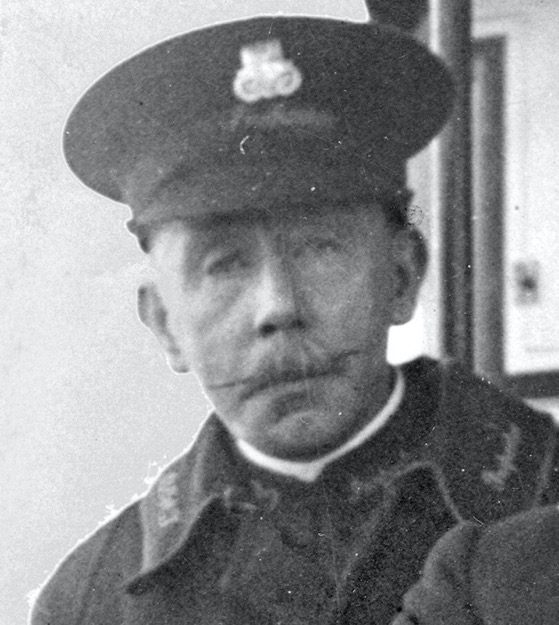
A blow-up of the above photo showing Inspector McEvoy, who is wearing an overcoat with piped collars, his grade embroidered on his left-hand side, and what appear to be system initials on his right-hand side. His cap also bears his grade (on an embroidered hat band) as well as the standard LStABT cap badge.